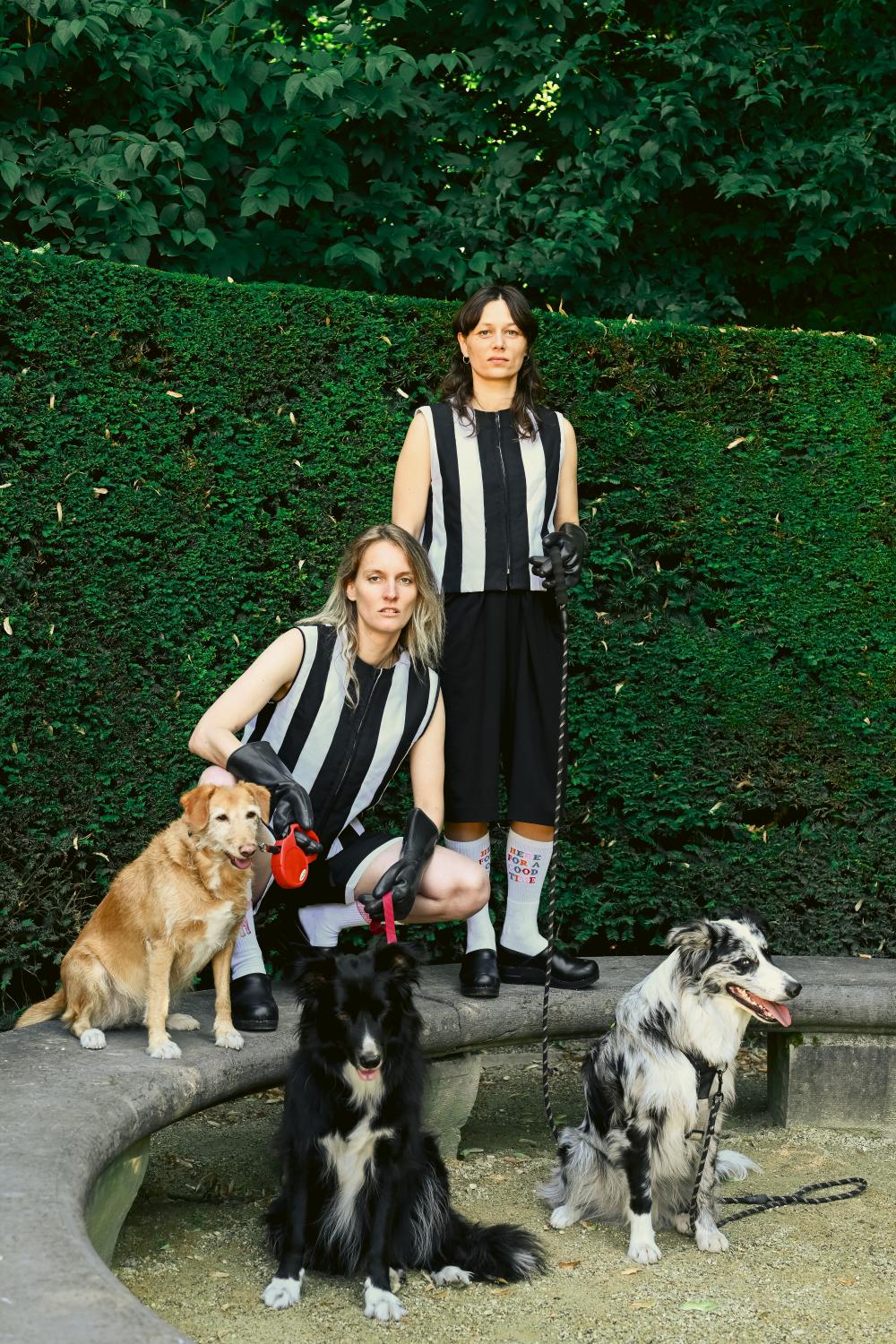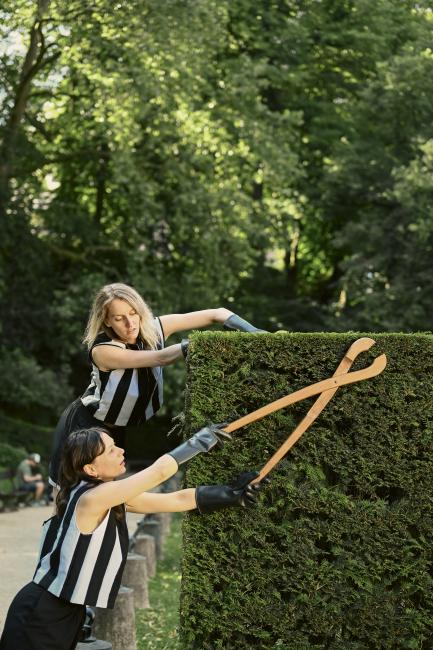buren is a verb.
interview with Oshin Albrecht and Melissa Mabesoone, by Agnes Quackels and Eva Decaesstecker (Kaaitheater, 2023)
In the essay "Building, Dwelling, Thinking", the German philosopher Martin Heidegger uses ‘buren’ as a verb. It is about constantly relating to your environment. In this interview, Oshin Albrecht and Melissa Mabesoone – who used this verb as a name for their collective – often translate it as 'nesting'. Another favourite pastime of theirs is inverting, going from the recognisable to something alien, from golf sticks to playground equipment.
How did your collaboration start?
MM: We met through a mutual friend and were often asked to do the same exhibitions within the visual arts. The better we got to know each other and each other's work, the more the idea of making something together took root. So we started applying together for every project proposal we could find.
OA: In early 2013, we were able to attend the Les Laboréales stage residency programme, which unwittingly became the first step in our careers on stage. Until then, our own installations and performances had always been in a visual context. As part of our visual work, we had also been doing scenography. We mostly created in situ, so the environment always played a role. That is also what inspired us to use buren (neighbour), as our name. 'To neighbour' is about constantly being in relationship with your surroundings. About how, where-ever you are, you help shape that place. This is also how we approached the black box.
MM: From that point on, we questioned the space differently: what does it mean to play in front of a group of people? How does the audience fit into the space? How do you address them? What is the power relationship between performers and their audience? How can you play with that? For us, to neighbour is about constantly nesting in that space and doing something with it. The performance we had created within Les Laboréales was first called buren. Later, we took that name for our collective and called the performance buren by buren.
You work multidisciplinary and many projects consist of multiple versions in different media. One of your performances (SPARE TIME WORK, 2022) becomes a songbook (STW, your favourite station!, 2023), a publication becomes a performance (Blue Skies Forever, 2018) and a video (To give voice to, 2018). Is there a set medium you start with and from which other forms emerge? Is there also a hierarchy in the media?
We often start from a collection of objects and images. Some objects prompt a particular action, others invite you to write something about them or stimulate looking. The starting material is often mundane, and we do not take that mundane for granted. Rather, we take it very seriously. We look for the object's poetical and political aspects. This is what happens, for example, with lyrics for existing songs, texts on t-shirts or advertising images, household items become magical props. They can transform us into Jean d'Arc or a poetry-writing Playboy bunny.
Most of our work is currently created and presented within the performing arts. But every time, derivative 'products' such as prints, objects, videos are created as part creation process. For us, it is a game with different forms of display, acting and image-making. Working on images for a book helps us understand how to proceed with forming images on stage. There is a constant interaction and in that sense, there is no hierarchy.
How do you deal with the separation between the visual scene and the stage world?
MM: We do not see that separation but we do notice that it exists because the audiences and the professionals around them are different. We have long had a desire to let these different audiences interact. For example, having spent some time at HISK, we found it sad that many of those we spoke to there about our first real black box performance did not get to see the final performance.
OA: While a performance is as much a work of art as an exhibition or a publication. On the other hand, for certain collaborations, we sometimes try to guide an audience towards another discipline. For example, by publishing images in nY or TIM Magazine or by presenting Spare Time Work's song book as part of an evening at VROOM – a space for contemporary graphic art.
Many of the scenes you create as part of your work include domestic features. Objects are sometimes abstract but many are very ordinary. Within it, you play your roles as female characters and question situations from a feminist perspective.
OA: Melissa lived in Amsterdam for a while and many of our conversations started to be about how we were approached in art school and what it means to be a non-male artist. We talked about our relationship with trustees, how they treat you and how you constantly have to relate to them. That it was harder to be taken seriously as a woman. The concept of home also featured regularly in our personal work. It is a place that says a lot about the 'feminine’ but also about caring. Most of the reproductive labour is done in the home. The architecture, the layout of the house and the way you can and may move in it often served as a starting point. The image of women, both in art history, advertising and history has been woven into our work for some time, but we only explicitly addressed it with Blue Skies Forever.
MM: Once we were able to make Blue Skies Forever, we really started focusing on stage effects. We look at the specific power relationship between the performers, who determine what is on show, versus the audience, who are there for enjoyment and have certain expectations. The show is very much about the gaze, what perspective you offer to the viewer, how an image is constructed and manipulated, and the way people look. We link the gaze, which in that performance is frontal, to the male gaze. As we were creating, we noticed a kind of self-censorship in ourselves, which then turned into a form of resistance. A resistance through transformations. We play with representations and preconceptions, transforming through voice acting, poses and costume changes.
What are your main sources of inspiration? Are there any artists, places or books that you keep referring back to?
OA: Musicals from 1950s come back often, mainly because of the scenography with endless spaces without corners or edges and in which new worlds constantly emerge in a very fluid way. There are also loads of writers, musicians and videographers who inspire us – from Lewis Caroll and Erika Beckman to Meredith Monk – but what stands out is the combination of popular or accessible sources and more intellectual references.
MM: Someone once said of buren by buren, our first project, that it is a mix of Tupperware, Jacques Tati and Chantal Akerman. I find that a good description. They also often compare it to Godard. Or Tik Tak for adults, which is a compliment too. The playful. I do somehow find it emancipatory, that playing that we show. We use humour but we also stay sharp and critical.
OA: Musicals too are very accessible and uncanny at the same time. They portray a world that represents the norm and which, at the same time, is not quite right.
Someone called that installing recognisability and then reversing that same recognisability. We work with that reversal too, sometimes literally! For example, we made a series of golf sticks that we literally bent into playthings or torture devices. The idea that you can distort a very rigid object or structure of meaning is always at play in our imagination. No matter how impossible, we always try to find ways around it.
You are currently working on a new show, shoe farm, which will première in February 2024. What is it about?
OA: shoe farm is based on our personal backgrounds. I grew up in a shoe shop and Melissa on a farm. If you combine the too, that becomes shoe farm. My father sarcastically called himself a 'shoe farmer'. We are interested in the work carried out in those two places. How that has affected the way we think about work and money. The performance builds on the previous show, SPARE TIME WORK, in which we examined the tension between work and leisure. We have already taken the first step in developing the different stages of shoe farm with the performance 7 Means Dinner for a Breadwinner. This is a scene unfolding, almost like a 17th-century painting, that gives you a (sometimes painfully) romantic view of peasants working the land. We then bend that image in all sorts of directions.
MM: In a way, that fusion of backgrounds has always been part of our collective work. 7 Means Dinner departed from a very specific fact. At dinnertime, my sister or I would call our father with a cowbell from the scullery far into the barn. "Daaaadyyy! It is time for diiiiinneer!". For the performance, we all collected cowbells and linked them to a technique called kulning used by women in Scandinavia to call animals back from grazing. The bell was of course also something that was very present in Oshin's background, when people came or left. In the Shoe department, there is the interaction with the customers, something we also want to make part of the show. We want to play with those links, whether obvious or not.
OA: We are really thinking of inviting two more performers on stage with us, to de-duplicate our own characters. That would mark a considerable step in our work. We mainly work in pairs with music, choreography or voice coaching support. Translating our language, our way of working, of moving, handling material to two other performers would be a challenge.

